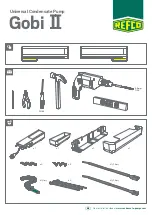
Johnson Controls
Start-Up & Operation Guide | 5586996-JSG-A-0120
Refer to the Premier 25–50 Ton Rooftop Units Instal-
lation and Maintenance Manual (5586959-JIM) that
shipped with the unit for additional information.
9
Start-Up
Start-Up
Long Term Storage
When a unit(s) is stored for an extended period of time,
conduct a visual inspection of the entire unit prior to
start-up to ensure there are no signs of damage, visible
leaks, or obstructions.
New motors should be relubricated on units kept in
long term storage for a year or more prior to start-up.
Apply power for 24 hours before starting the unit to en-
sure that any refrigerant that may have migrated to the
compressor has evaporated.
Checking System Prior to Initial Start (No
Power)
(multi zone variable air volume (MZVAV) units),
building static pressure transducer for power ex-
haust option, and outdoor static pressure probe.
10. Ensure the tie-down shipping bolts, washers,
and spacers for the supply, exhaust, and/or re-
turn fan isolator springs are removed.
11. Ensure the ultraviolet (UV) tube lights have been
installed if applicable.
12. Verify proper bearing and locking collar torque
values on supply and exhaust fans.
13. Verify proper drive alignment of return and ex-
haust fans.
14. Verify proper belt tension of the exhaust fan or
return fan in accordance with instructions in the
Installation and Maintenance Manual. Belts must
be checked after 24 hours of initial operation.
15. Manually rotate condenser fan blades; supply,
exhaust, and return blower wheels; and motors
to ensure freedom of movement.
16.
If applicable, verify installation of air filters.
17. If equipped, open the suction line ball valve, dis-
charge line ball valve, and liquid line ball valve
for each refrigerant system
18. Zero the magnehelic gauge. Use the external zero
adjust screw on the bottom of the cover to set the
indicating pointer exactly on the zero mark.
NOTE:
The high and low pressure taps must both be
open to atmosphere in order to make the zero
adjustment.
19. Verify proper condensate drain trap installation.
Fill traps with water prior to unit start-up (
20.
Verify the condensate float switch is located just
before the top of the drain pan. Adjust if necessary.
21. Check for gas leaks in the unit piping and the
field supply piping.
H must be at least 1 + Fan Total
Static Pressure
H
X
X = 1/2(H)
LD05370
Figure 1: Trap Detail for Draw Through Application
1. Inspect the unit for shipping or installation damage.
2. Visually check for refrigerant piping leaks.
3. The compressor oil level should be maintained
so that an oil level is visible in the sight glass, if
equipped. The oil level can only be tested when
the compressor is running in stabilized condi-
tions, guaranteeing that there is no liquid refrig-
erant in the lower shell of the compressor. In this
case, the oil must be between 1/4 and 3/4 in the
sight glass. At shutdown, the oil level can fall to
the bottom limit of the oil sight glass.
For 40 and 50 ton high efficiency units ONLY, an
optical sensor is provided over the sight glass,
in which the unit controller monitors the correct
oil level. If too low, the unit controller adjusts the
compressor speed to try to recover oil to the com-
pressor. If that fails, then the unit controller shuts
off the compressor
4. Check the control panel to ensure it is free of for-
eign material (wires, metal chips, etc.).
5.
Visually inspect field wiring (power and control).
Wiring MUST meet the National Electrical Code
®
(NEC) and local codes.
6. Check tightness of terminal lugs inside the power
panel on both sides of the contactors, overloads,
fuses, and power connections.
7. Verify fuse sizing in main circuits.
8.
Verify field wiring for thermostat (if applicable),
optional zone sensor, etc.
9. Verify all applicable pneumatic tubing has been
field installed for duct static pressure transducer










































